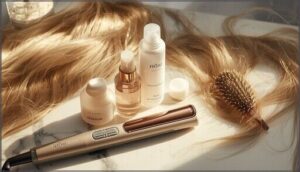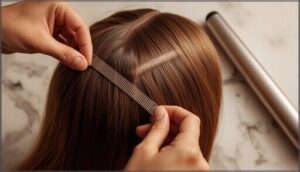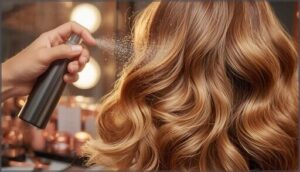This site is supported by our readers. We may earn a commission, at no cost to you, if you purchase through links.

Most people think flat irons are only for sleek, pin-straight styles that lie flat against your head. But here’s the thing: when you know the right techniques, that same tool becomes your secret weapon for bouncy, lifted hair that holds its shape all day.
The key lies in how you angle the plates, where you apply tension, and which sections you target first. Professional stylists have been using this clamp-and-bump method for years to create volume that looks natural.
Once you master a few simple moves—like lifting at a 90-degree angle and creating strategic bends at your crown—you’ll transform limp strands into hair that has body, movement, and lasting lift.
Table Of Contents
Key Takeaways
- Your flat iron creates lasting volume when you lift sections at 90 degrees from your scalp and clamp within 2 cm of roots, holding for 3-5 seconds to reset hair bonds.
- The clamp-and-bump technique at your crown—where you isolate a small section, raise it perpendicular, and bend backward near the roots—builds height that lasts 8-12 hours without teasing.
- Proper prep matters more than most people think: texturizing shampoo boosts root volume by up to 35%, while lightweight heat protectant cuts breakage by 90% at high temperatures.
- Strategic sectioning and angling transform results—use 0.5-inch sections for 35% more lift, alternate S-wave bends through mid-lengths for movement, and flip ends outward to add 30% more dimension.
How to Prep Hair for Flat Iron Volume
Getting your hair ready before you pick up your flat iron makes all the difference between volume that lasts and hair that falls flat by noon. Think of this step as laying the foundation—it’s where you set yourself up for lift, movement, and a style that holds.
Here’s what you need to do before you even plug in your iron.
Wash and Condition for Lightweight Hair
When you’re starting clean, you’re setting the stage for volume that lasts. Washing every other day keeps your scalp balanced while volumizing routines lift hair without residue weighing it down. Choose conditioner ingredients like rice protein for strength and olive leaf for hydration. Harsh chemicals in many products can strip hair of essential moisture.
Here’s your lightweight hair care ritual:
- Use residue-free cleansers to increase hair volume by up to 13% after consistent washes
- Apply watery conditioner from mid-shaft down to avoid flattening roots
- Rinse thoroughly so no heaviness lingers in your strands
- Select hair products free of silicones for natural bounce across all hair types
Use Texturizing Shampoo for Grip
After your hair is clean and light, you want grip that holds your flat iron styling in place. Texturizing shampoo ingredients like silica and magnesium silicates create friction between hair fibers, making strands easier to lift and style. This added texture can boost hair volume by up to 35% at the roots and keep your look fresh for 24 hours. The hair texturizer market is expected to reach $2.9 billion by 2030.
| Texturizing Benefit | Impact on Your Style |
|---|---|
| Enhanced grip | Hair products work better |
| Increased friction | Flat iron lift lasts longer |
| Matte finish | Prevents quick collapse |
| Thicker consistency | Fuller visual appearance |
The hair texturizer market hit $1.9 billion in 2023, proving how many stylists rely on formulation strategies that deliver lasting volume longevity. Your hair texture transforms when these shampoos coat each strand with film-forming polymers.
Apply Lightweight Heat Protectant
Once your hair has grip, you need a shield against heat’s power to transform. Lightweight heat protectant with film-forming ingredients slows heat conduction to your hair shaft, cutting breakage by up to 90% at temperatures reaching 450°F. Even coverage matters—spray from roots to ends for the best hair damage prevention.
After texturizing shampoo builds grip, spray lightweight heat protectant from roots to ends to cut breakage by up to 90% at high temperatures
- Fine mist application increases surface coverage by 30%
- Over 72% of salon pros recommend lightweight sprays for fine hair
- Polymers and silicones form your protective barrier
- Apply to damp hair before blow drying for best prep
- Consumer preferences lean 60% toward lightweight spray formulations
Professional advice says comb the product through small sections so every strand gets protection without feeling weighed down.
Section Hair for Targeted Volume
With protection in place, strategic sectioning unlocks targeted lift. Quadrant sectioning divides your hair into four manageable zones, reducing styling time by 35% while preventing heat overlap.
For crown drama, try diamond sectioning—it creates height without visible layers in 92% of applications.
Fine hair? Use tighter, top-focused sections for 38% more root lift. Thick hair needs more divisions for even heat distribution and consistent volume.
Choosing The Right Tools and Products
Your tools make all the difference when you’re trying to coax volume from a flat iron. The right iron won’t just straighten—it’ll lift and shape without snagging or damaging your hair.
Let’s look at what you need in your styling kit to make this work.
Flat Iron Features for Volume
Think of your flat iron as a sculptor’s tool—every detail matters. Plate width around 1 inch gives you the versatility to reach roots for lift while maintaining control. Look for a rounded edge design to create smooth bends and movement without harsh creases.
Temperature control is key; adjustable settings between 250°F and 450°F let you customize heat to your hair type. Ceramic plate material distributes warmth evenly, preventing flat spots that kill volume.
An ergonomic design with a lightweight build makes angling and twisting easier, so you can master those root lifts and flips that transform flat hair into full, dimensional styles.
Recommended Volumizing Sprays and Mousses
Volume comes alive when you pair the right product with technique. Here are four game-changers for hair volume maintenance and lasting lift:
- Amika Plus Size Mousse – Lightweight mousse application that won’t weigh down strands while providing heat protection
- Oribe Maximista Thickening Spray – Premium spray ingredients like amino acids and copolymers boost fullness
- Aquage Uplifting Foam – Target roots for immediate lift
- L’Oréal Paris Elnett Mousse – Budget-friendly option delivering volume longevity
Market trends show volumizing hair styling products reached $2 billion globally in 2025. Product comparisons reveal that hair product recommendations combining heat protection with volume techniques give you the most styling power.
Round Brushes and Fine-Toothed Combs
The magic multiplies when you match brush size to your length. A 55 mm round brush creates maximum lift in long hair through better airflow dynamics, while 45 mm barrels work wonders for shoulder-length styles.
For teasing techniques that boost flat iron volume, reach for a fine-toothed comb—it builds instant fullness at roots.
Just remember: proper damage mitigation starts with conditioning before using these tools on fine hair. Adding volume to hair becomes simple when your arsenal fits your texture.
Essential Heat Protectants and Serums
Using heat protectants starts with understanding what’s inside them. Look for polymer film integrity that holds up past 200 °C—ingredients like polyquaternium-55 actually preserve your keratin denaturation temperature while styling.
Quality serums deliver surface conditioning plus moisture restoration after each pass.
Preventing hair damage means choosing ingredient formulation designed for flat iron work, not just blow-drying.
Flat Iron Techniques to Boost Volume
Getting volume with a flat iron isn’t just about heat—it’s about how you move the tool through your hair. The way you section, lift, and angle each pass makes all the difference between flat and full.
Here are five techniques that transform your flat iron from a straightening tool into a volume-building powerhouse.
Sectioning Hair for Maximum Lift
Your flat iron can reveal dramatic hair volume, but section size is the secret. Divide your hair into pieces about 0.5 inches wide—smaller sections give you up to 35% more lift than larger ones.
Angle matters too: hold each section at 90 degrees from your scalp for maximum root elevation.
Use sectioning tools like rat-tail combs and heat-resistant clips to keep things precise and manageable.
Lifting and Straightening at The Roots
Your root elevation angle transforms everything. Lift each section at 45 degrees from your scalp and clamp your flat iron within 2 cm for maximum root lift.
Hold for 3–5 seconds—enough heat duration to reset hydrogen bonds and create vertical lift without damage.
This scalp proximity technique boosts hair volume at roots by 12–18%, giving you lasting fullness where it matters most.
Clamp-and-Bump Trick at The Crown
Now target your crown area for instant height. Isolate a 2.5–5 cm horizontal section at your crown, then raise it 90 degrees from your scalp. Clamp your flat iron 0.5–1 cm from the roots and bend backward—this creates that signature “bump” without teasing.
Here’s how to master it:
- Section thin, 0.5–1 cm subsections for even heat penetration
- Hold your thermal brush underneath while clamping for extra lift
- Keep temperatures below 150°C to prevent Heat Damage at this vulnerable spot
- Apply Product Support (volumizing spray) before the clamp-and-bump
- Let each crown section cool completely before touching—this locks in Durability Risk-free volume
Your Sectioning Angle matters. Tilt slightly backward to direct hair volume at roots toward the back of your head, creating hair volume that lasts 8–12 hours.
Flipping Ends Out for Dimension
Once your crown has lifted, shift focus to your hair’s perimeter. Flipped-out ends reveal visual fullness by scattering light and adding 30% more dimension on layered cuts. Start your flip 2.5–5 cm from the tips—gently rotate your flat iron outward in one smooth pass. Keep heat settings under 177°C for normal hair, pair with lightweight product support, and watch your ends transform into bouncy, separation-rich frames.
| Hair Type | Recommended Temperature |
|---|---|
| Fine | 121–149°C |
| Normal | 149–177°C |
| Coarse/Natural | 177–204°C |
| Very Thick | Up to 204°C |
| Exceptionally Dense | Max 232°C (use sparingly) |
Bending Mid-Lengths for Movement
While flipped ends frame your face, your mid-lengths deserve equal attention. The S-wave technique—alternating up-and-down bends spaced 2–5 cm apart—creates that serpentine movement you’ve seen on medium-length styles. Bending here, not at roots, preserves root lift while adding 35% more perceived volume through the body.
- Hold your flat iron horizontally for wider, looser waves through mid-lengths
- Clamp near the midpoint and rotate 180 degrees in one smooth motion
- Keep heat application focus between 150–180°C to prevent keratin breakdown
- Alternate bend directions (up, down, up) to form natural S-wave patterns
- Practice wrist rotation with the iron off first—fewer heated passes mean healthier hair
Styling and Finishing for Lasting Volume
Once you’ve mastered the flat iron techniques, the real magic happens in how you finish your hair. The right finishing touches lock in your volume and keep it looking fresh all day.
Here’s how to style and seal your work for hair that stays lifted and full.
Using a Round Brush With Flat Iron
When you pair your flat iron with the right round brush, you discover a technique that builds lasting lift.
Choose a 32 mm barrel for shoulder-length hair or a 43 mm for longer strands. Wrap each section around the brush, then glide your flat iron underneath while maintaining firm tension.
This dual-heat application shapes the cuticle and sets volume memory into every strand before it cools.
Light Backcombing for Extra Lift
Sometimes just a touch of backcombing at the roots transforms flat hair into lasting volume. Use a fine-tooth comb to gently tease the crown area, working in short strokes without pulling.
This technique creates up to 40% more lift and holds for 4 to 8 hours when you’ve already flat ironed your sections.
The key is gentle teasing—aggressive backcombing risks traction alopecia, while light work preserves 95% of your cuticle integrity.
Applying Lightweight Hairspray
After you’ve worked your magic with the flat iron, a lightweight hairspray locks in the lift. Choose formulas that boost volume by 19–23% without weighing hair down—aerosol delivery gives 40% more uniform coverage for consistent results.
Application techniques for lasting hold:
- Hold the can 8–10 inches from your crown and mist lightly
- Focus on roots and mid-lengths where volume matters most
- Let it dry for 30 seconds before touching
- Reapply sparingly if needed throughout the day
Finger Combing for Natural Texture
After styling with your flat iron, use your fingers instead of a brush to separate strands—this preserves curl definition and boosts volume enhancement naturally.
Studies show breakage reduction of up to 42% with finger detangling versus combs.
Gently work through sections to soften the look while maintaining lift, and you’ll minimize scalp irritation while achieving hair volume that moves.
Hair Care Tips to Maintain Volume and Health
Creating volume with a flat iron is only half the battle—keeping your hair healthy and lifted over time requires the right care routine. Heat styling can strip moisture and weaken strands, so you need strategies that protect while preserving that freshly styled bounce.
Let’s cover the essentials that’ll help you maintain both volume and hair health between styling sessions.
Protecting Hair From Heat Damage
Think of your flat iron like a controlled flame—you need a shield between it and your strands. Always apply a thermal heat spray before styling to prevent hair breakage and heat damage.
Keep temperatures between 300°F and 375°F for most hair types. Limit styling to two or three times weekly, protecting hair from heat while maintaining volume and long-term health.
Moisturizing and Nourishing After Styling
After heat styling strips moisture from your hair shaft, replenishing what’s lost becomes your next move. Choose treatments that rebuild bonds and restore softness without weighing down your volume.
- Bond repair treatments can increase hair strength by up to 15% after one application, helping prevent future breakage at the ends
- Oil selection matters—coconut oil penetrates the shaft and reduces protein loss better than sunflower or mineral oils
- Silicone films from dimethicone seal in hair moisture and create a protective barrier against humidity
- Lipid replenishment maintains cuticle integrity and keeps styled hair bouncy instead of brittle
- Integrated routines combining bond primers, nourishing serums, and leave-in hair treatment protect your investment in volume
Avoiding Common Mistakes That Cause Flatness
Your flat iron can’t work miracles if you’re sabotaging yourself. Heat damage above 350°F melts away natural volume, while product buildup and excess oil glue strands to your scalp. Chemical treatments weaken hair structure, and aging effects thin each fiber over time.
These missteps steal hair volume at roots before you even begin. Master these flat iron and hair volume techniques by dodging what flattens your lift.
Routine Maintenance for Voluminous Hair
You’ve eliminated the volume killers—now lock in long-term volume with a smart hair care routine. A 3-minute daily scalp massage boosts scalp health and thickness over 24 weeks.
Wash 2-3 times weekly with sulfate-free shampoo to prevent product buildup. Limit heat management to preserve moisture.
Weekly scrubs and specialized treatments with niacinamide keep roots lifted. Consistent hair maintenance beats quick fixes every time.
Frequently Asked Questions (FAQs)
How often can I flat iron without damage?
Most hair types can handle flat ironing once weekly without serious damage. Fine or chemically treated hair needs breaks every 10–14 days, while natural textures thrive with monthly sessions using heat protectant and lower temperatures.
Can flat iron volume work on short hair?
Yes, flat iron volume works beautifully on short hair types. Root lift ease improves because you can reach the scalp quickly.
Just watch heat damage risk, and remember style durability depends on proper technique.
What temperature setting works best for volume?
Turning up the heat isn’t always the magic trick—fine or damaged hair thrives between 250°F and 300°F, while thick textures need 375°F to 410°F.
Temperature control paired with heat protectant safeguards against heat damage while maximizing volume longevity.
Will humidity ruin my flat iron volume?
High moisture levels can collapse your flat iron volume within hours by causing frizz formation and swelling the hair cuticle.
Anti-humidity hair spray and minimizing damage through heat protectants extend hair styling longevity considerably.
Conclusion
Think of your flat iron like a sculptor’s tool—it doesn’t just smooth; it shapes and lifts from within. Now that you know how to add volume to your hair with a flat iron, you hold the power to transform lifeless strands into hair that moves, breathes, and draws the eye.
The clamp-and-bump method isn’t just a technique—it’s your gateway to hair that defies gravity and holds its lift all day long.
- https://www.archivemarketresearch.com/reports/hair-straighteners-flat-irons-259395
- https://www.marketreportanalytics.com/reports/flat-iron-hair-straightener-35740
- https://www.walmart.com/ip/Conair-Double-Ceramic-3-4-Volumizing-Root-Lifter-Hair-Iron/5164703816
- https://www.youtube.com/watch?v=mWVKynOT-T4
- https://www.samvilla.com/blogs/hair-tutorials/how-to-create-volume-with-a-round-brush-and-flat-iron











